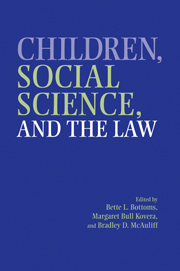Book contents
- Frontmatter
- Contents
- Acknowledgments
- Contributors
- 1 Children, Social Science, and the Law: An Introduction to the Issues
- PART I CHILDREN'S RIGHTS, THEIR CAPABILITIES, AND SOCIETY'S RESPONSIBILITIES TO CHILDREN
- 2 The Personal Responsibility and Work Opportunity Reconciliation Act of 1996: What Will It Mean for Children?
- 3 Advocacy for Children's Rights
- 4 Children's Rights and Capacities
- 5 Children's Legal Representation in Civil Litigation
- PART II CHILDREN AND FAMILY CHANGE
- PART III JUVENILE AGGRESSION AND JUVENILE JUSTICE
- PART IV CHILDREN AS VICTIMS AND WITNESSES
- PART V CONCLUSIONS AND FUTURE DIRECTIONS
- Author Index
- Case Index
- Subject Index
- References
5 - Children's Legal Representation in Civil Litigation
Published online by Cambridge University Press: 24 July 2009
- Frontmatter
- Contents
- Acknowledgments
- Contributors
- 1 Children, Social Science, and the Law: An Introduction to the Issues
- PART I CHILDREN'S RIGHTS, THEIR CAPABILITIES, AND SOCIETY'S RESPONSIBILITIES TO CHILDREN
- 2 The Personal Responsibility and Work Opportunity Reconciliation Act of 1996: What Will It Mean for Children?
- 3 Advocacy for Children's Rights
- 4 Children's Rights and Capacities
- 5 Children's Legal Representation in Civil Litigation
- PART II CHILDREN AND FAMILY CHANGE
- PART III JUVENILE AGGRESSION AND JUVENILE JUSTICE
- PART IV CHILDREN AS VICTIMS AND WITNESSES
- PART V CONCLUSIONS AND FUTURE DIRECTIONS
- Author Index
- Case Index
- Subject Index
- References
Summary
Children's legal representation has developed in a largely ad hoc manner among the states, with little concern for traditional ethical principles of zealous advocacy, children's constitutional rights, or attorneys' malpractice liability (Haralambie, 1993). It has not even been clear whether children have any right to be represented in civil litigation by counsel, either appointed or privately retained. Although the U.S. Supreme Court articulated a constitutional right to independdent representation for children in certain delinquency cases (Arizona v. Gault, 1967), no similar constitutional right has been declared for children involved in the child welfare system or family courts. (For a discussion of the history, current status, and future of the children's legal rights advocacy movement, see Small & Limber, this volume.)
Children most often have independent representation in child welfare proceedings filed by child protective services agencies to free children temporarily or permanently from their parents' care because of abuse, neglect, or abandonment. Much less frequently, children have independent representation in custody cases between the child's parents or between a parent and a private third party such as a grandparent. Children are more likely to have independent representation in custody cases when issues of abuse or neglect are raised by one of the private parties. The rationale for appointing independent representation for children is (a) to provide an independent person to advocate for their best interests and (b) to give children a voice for their expressed position in cases that so directly impact their lives.
- Type
- Chapter
- Information
- Children, Social Science, and the Law , pp. 106 - 128Publisher: Cambridge University PressPrint publication year: 2002

